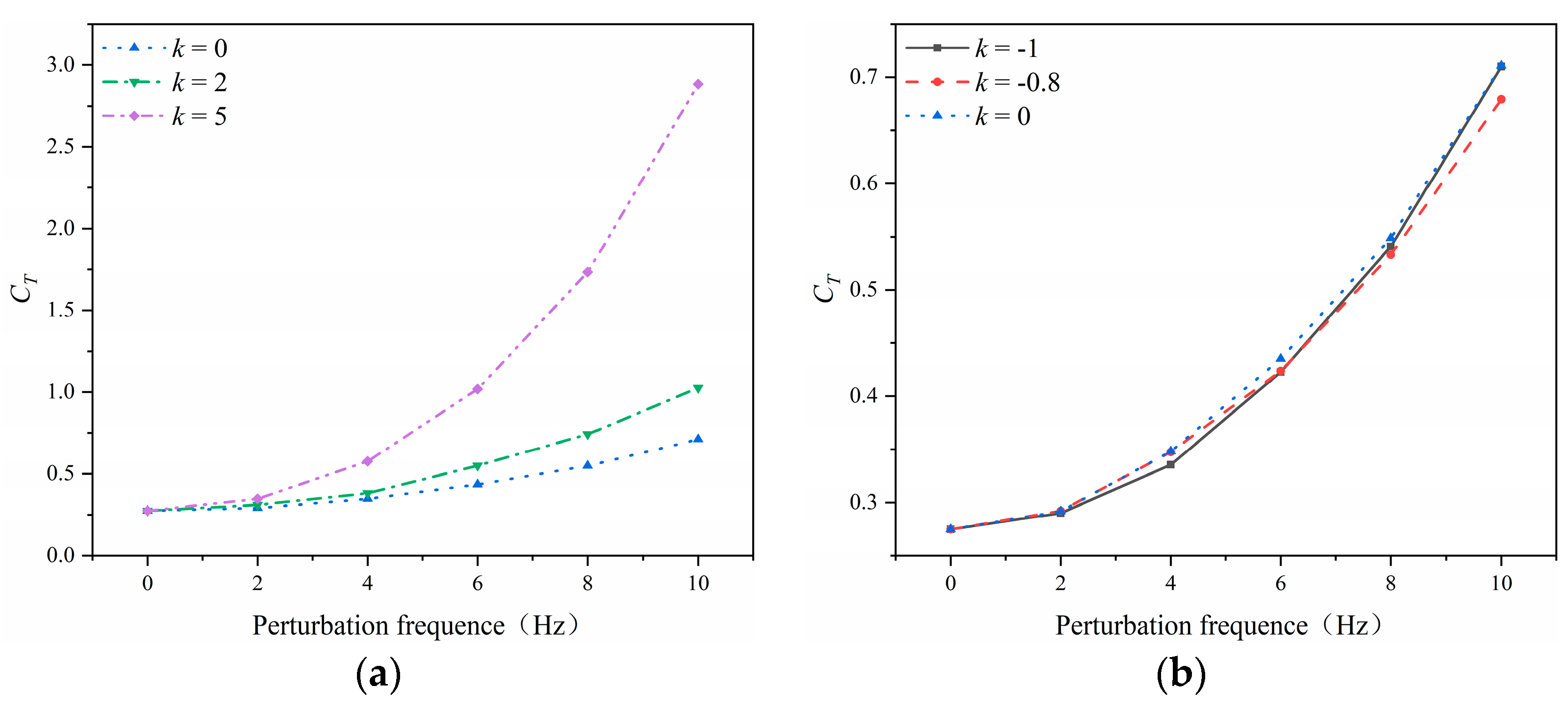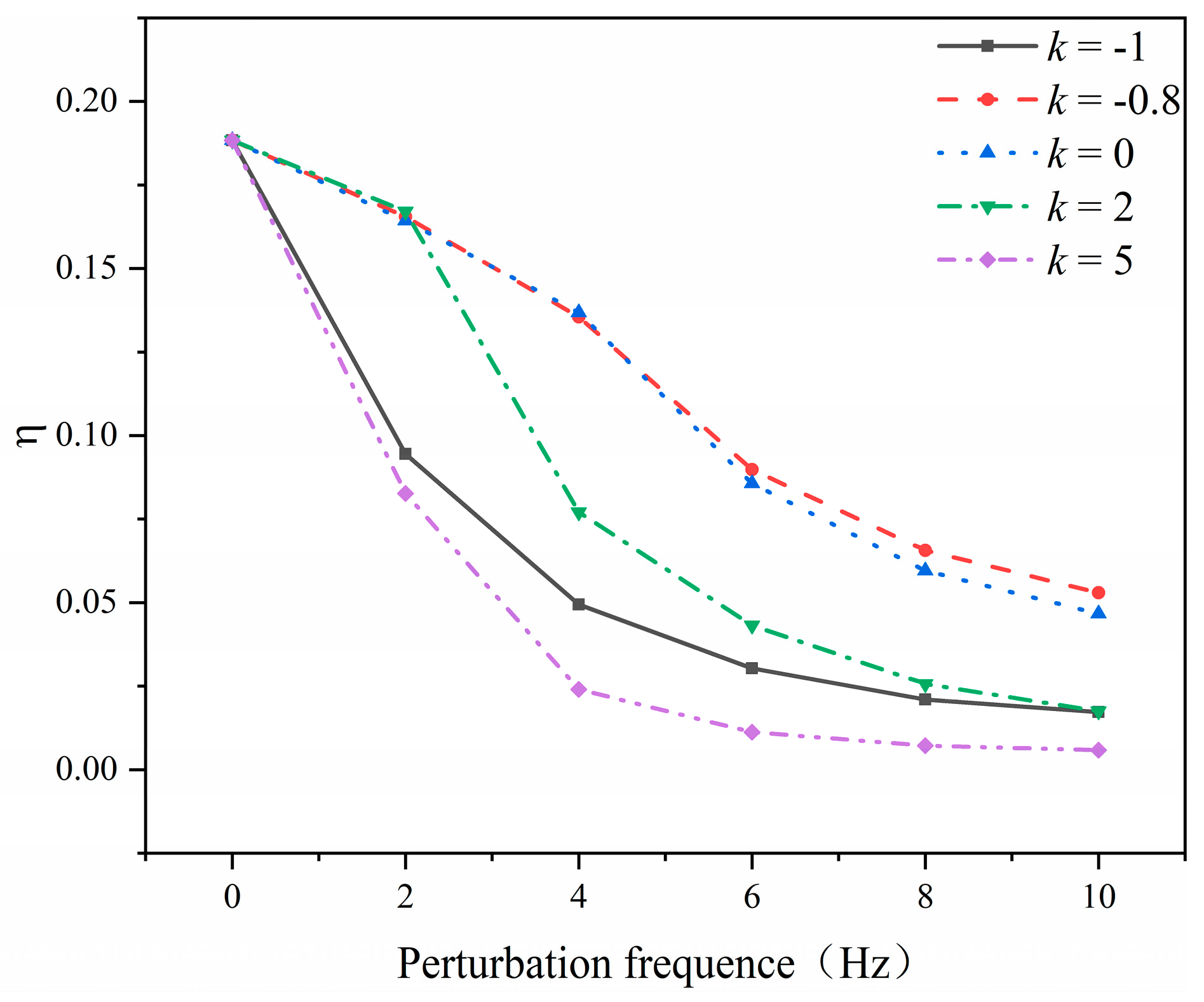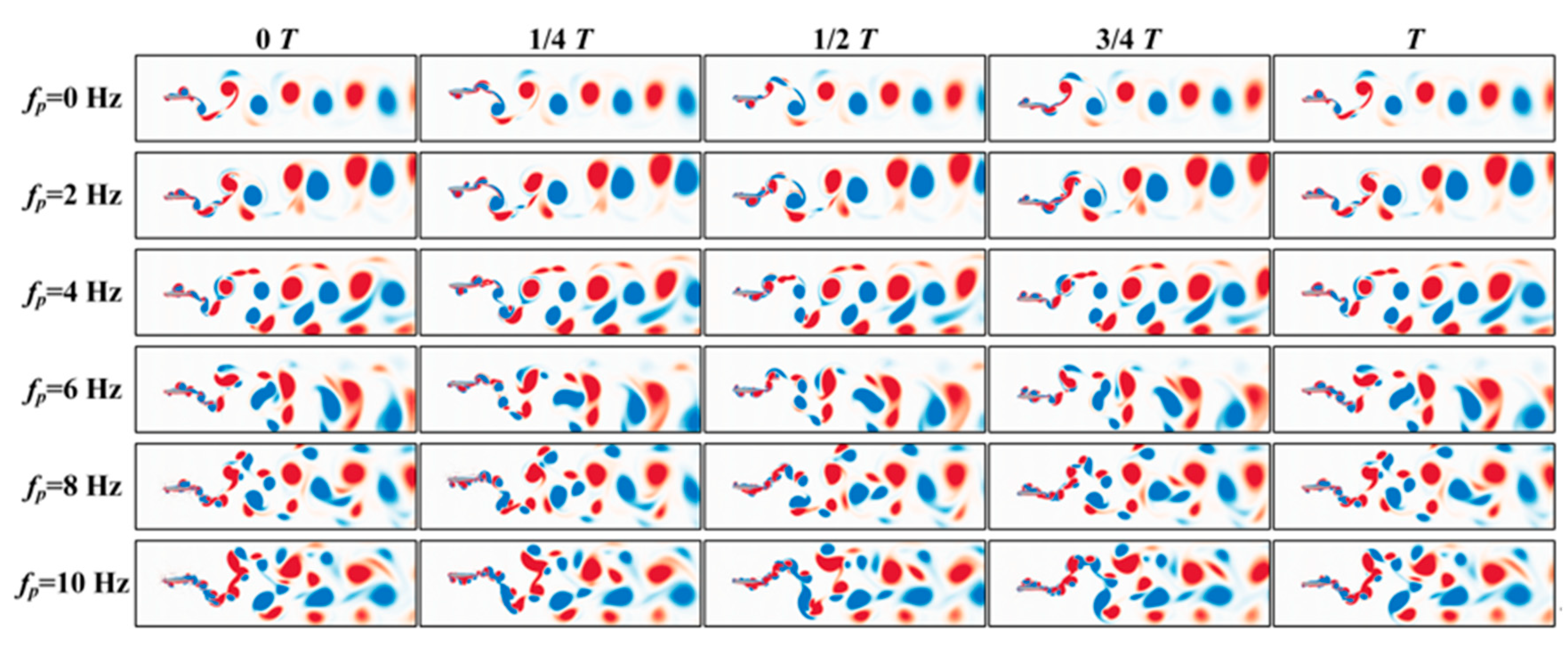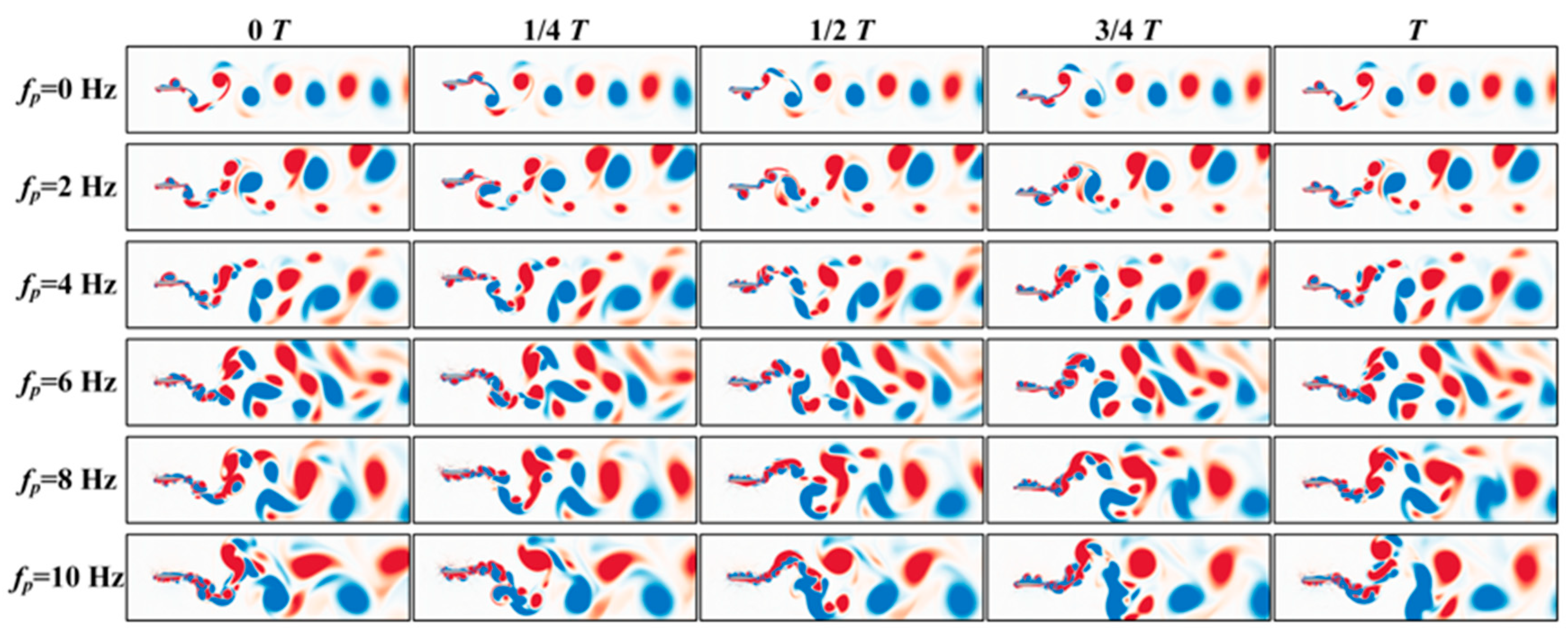Propulsion Performance and Wake Dynamics of Heaving Foils under Different Waveform Input Perturbations
Abstract
:1. Introduction
2. Problem Definition and Methodology
2.1. Problem Definition
2.2. Numerical Approach
2.3. Validations
3. Result and Discussion
3.1. Force Measurement
3.2. Wake Structures
4. Conclusions
- The addition of any waveform perturbation increases the axial thrust, especially when a square wave (k = 5) perturbation with a frequency of 10 Hz is applied, which directly raises the thrust to 10.49 times higher than when no perturbation is added. A response function is obtained which gives the relationship between the input perturbation parameters and the thrust coefficients.
- However, the propulsion efficiency decreases gradually with the increase of the perturbation frequency, especially when a sawtooth wave perturbation (k = −1) is applied, which brings limited thrust gain but a rapid decrease in the propulsion efficiency.
- The wake structure is roughly the same for different waveform perturbations, all of which first go through an asymmetric wake phase (at fp = 2 Hz). With increasing perturbation frequency, adding sine wave perturbation (k = 0) and sawtooth wave perturbation (k = −1, −0.8) leads to a complex wake phase (at fp = 4 Hz) and then evolves to a chaotic wake; adding square wave perturbation (k =2) keeps the asymmetric wake at fp = 4 Hz and then evolves to a chaotic wake; adding square wave perturbation (k = 5) leads to a direct evolution from an asymmetric wake to a chaotic wake.
- The simulation results have a guiding meaning for the setting of the vehicle motion parameters. The control signal of the vehicle tries to avoid the use of sawtooth wave signal. It can consider sacrificing part of the propulsion efficiency and adding a square wave signal to the drive signal to promote the vehicle gaining greater thrust. To ensure high propulsion efficiency for a long voyage, a sinusoidal signal (or a signal with k = −0.8) can be added to the drive signal. The waveform signal with k = 2 seems to be the most cost-effective choice, which provides a larger thrust without a significant decrease in propulsion efficiency.
Author Contributions
Funding
Institutional Review Board Statement
Informed Consent Statement
Data Availability Statement
Conflicts of Interest
References
- Garrick, I.E. Propulsion of a flapping and oscillating airfoil. NACA Rep. 1937, 567, 419–427. [Google Scholar]
- Gray, J. Studies in animal locomotion: VI. The propulsive powers of the dolphin. J. Exp. Biol. 1936, 13, 192–199. [Google Scholar] [CrossRef]
- Lighthill, M.J. Hydromechanics of aquatic animal propulsion. Annu. Rev. Fluid Mech. 1969, 1, 413–446. [Google Scholar] [CrossRef]
- Wu, T.Y. Fish swimming and bird/insect flight. Annu. Rev. Fluid Mech. 2011, 43, 25–58. [Google Scholar] [CrossRef]
- Shiau, J.; Watson, J.R.; Cramp, R.L.; Gordos, M.A.; Franklin, C.E. Interactions between water depth, velocity and body size on fish swimming performance: Implications for culvert hydrodynamics. Ecol. Eng. 2020, 156, 105987. [Google Scholar] [CrossRef]
- Downie, A.T.; Illing, B.; Faria, A.M.; Rummer, J.L. Swimming performance of marine fish larvae: Review of a universal trait under ecological and environmental pressure. Rev. Fish Biol. Fish. 2020, 30, 93–108. [Google Scholar] [CrossRef]
- Russo, R.S.; Blemker, S.S.; Fish, F.E.; Bart-Smith, H. Biomechanical model of batoid (skates and rays) pectoral fins predicts the influence of skeletal structure on fin kinematics: Implications for bio-inspired design. Bioinspiration Biomim. 2015, 10, 046002. [Google Scholar] [CrossRef] [PubMed] [Green Version]
- Tytell, E.D.; Leftwich, M.C.; Hsu, C.Y.; Griffith, B.E.; Cohen, A.H.; Smits, A.J.; Hamlet, C.; Fauci, L.J. Role of body stiffness in undulatory swimming: Insights from robotic and computational models. Phys. Rev. Fluids. 2016, 1, 073202. [Google Scholar] [CrossRef]
- Mao, L.; Wang, H.; Li, Y.; Yi, H. Force model of flapping foil stabilizers based on CFD parameterization. Ocean Eng. 2019, 187, 106151. [Google Scholar] [CrossRef]
- Wu, W. Study on the self-propulsion of the rigid-flexible composite plate. Fluid Dyn. Res. 2021, 53, 045501. [Google Scholar] [CrossRef]
- Cros, A.; Castro, R.F.A. Experimental study on the resonance frequencies of a cantilevered plate in air flow. J. Sound Vib. 2016, 363, 240–246. [Google Scholar] [CrossRef]
- Eloy, C.; Souilliez, C.; Schouveiler, L. Flutter of a rectangular plate. J. Fluids Struct. 2007, 23, 904–919. [Google Scholar] [CrossRef]
- Michelin, S.; Llewellyn Smith, S.G. Resonance and propulsion performance of a heaving flexible wing. Phys. Fluids 2009, 21, 071902. [Google Scholar] [CrossRef] [Green Version]
- Root, R.G.; Courtland, H.W.; Shepherd, W.; Long, J.H. Flapping flexible fish. In Animal Locomotion, 1st ed.; Taylor, G.K., Triantafyllou, M.S., Tropea, C., Eds.; Springer: Berlin/Heidelberg, Germany, 2010; pp. 141–159. [Google Scholar]
- Root, R.G.; Liew, C.W. Computational and mathematical modeling of the effects of tailbeat frequency and flexural stiffness in swimming fish. Zoology 2014, 117, 81–85. [Google Scholar] [CrossRef]
- Grillner, S. Neural control of locomotion in lower vertebrates: From behavior to ionic mechanisms. Neural Control. Rhythm. Mov. Vertebr. 1988, 1, 1–40. [Google Scholar]
- Pearson, K.G. Common principles of motor control in vertebrates and invertebrates. Annu. Rev. Neurosci. 1993, 16, 265–297. [Google Scholar] [CrossRef]
- Pearson, K.G. Generating the walking gait: Role of sensory feedback. Prog. Brain Res. 2004, 143, 123–129. [Google Scholar] [PubMed]
- Lehn, A.M.; Thornycroft, P.J.; Lauder, G.V.; Leftwich, M.C. Effect of input perturbation on the performance and wake dynamics of aquatic propulsion in heaving flexible foils. Phys. Rev. Fluids 2017, 2, 023101. [Google Scholar] [CrossRef]
- Lu, K.; Xie, Y.H.; Zhang, D. Numerical study of large amplitude, nonsinusoidal motion and camber effects on pitching airfoil propulsion. J. Fluids Struct. 2013, 36, 184–194. [Google Scholar] [CrossRef]
- Read, D.A.; Hover, F.S.; Triantafyllou, M.S. Forces on oscillating foils for propulsion and maneuvering. J. Fluids Struct. 2003, 17, 163–183. [Google Scholar] [CrossRef]
- Heathcote, S.; Gursul, I. Jet switching phenomenon for a periodically plunging airfoil. Phys. Fluids 2007, 19, 027104. [Google Scholar] [CrossRef]
- Ashraf, M.A.; Young, J.; Lai, J.C.S. Oscillation frequency and amplitude effects on plunging airfoil propulsion and flow periodicity. AIAA J. 2012, 50, 2308–2324. [Google Scholar] [CrossRef]
- Gao, P.; Huang, Q.; Pan, G.; Zhao, J. Effects of flexibility and motion parameters on a flapping foil at zero freestream velocity. Ocean Eng. 2021, 242, 110061. [Google Scholar] [CrossRef]










Publisher’s Note: MDPI stays neutral with regard to jurisdictional claims in published maps and institutional affiliations. |
© 2021 by the authors. Licensee MDPI, Basel, Switzerland. This article is an open access article distributed under the terms and conditions of the Creative Commons Attribution (CC BY) license (https://creativecommons.org/licenses/by/4.0/).
Share and Cite
Gao, P.; Huang, Q.; Pan, G. Propulsion Performance and Wake Dynamics of Heaving Foils under Different Waveform Input Perturbations. J. Mar. Sci. Eng. 2021, 9, 1271. https://doi.org/10.3390/jmse9111271
Gao P, Huang Q, Pan G. Propulsion Performance and Wake Dynamics of Heaving Foils under Different Waveform Input Perturbations. Journal of Marine Science and Engineering. 2021; 9(11):1271. https://doi.org/10.3390/jmse9111271
Chicago/Turabian StyleGao, Pengcheng, Qiaogao Huang, and Guang Pan. 2021. "Propulsion Performance and Wake Dynamics of Heaving Foils under Different Waveform Input Perturbations" Journal of Marine Science and Engineering 9, no. 11: 1271. https://doi.org/10.3390/jmse9111271




